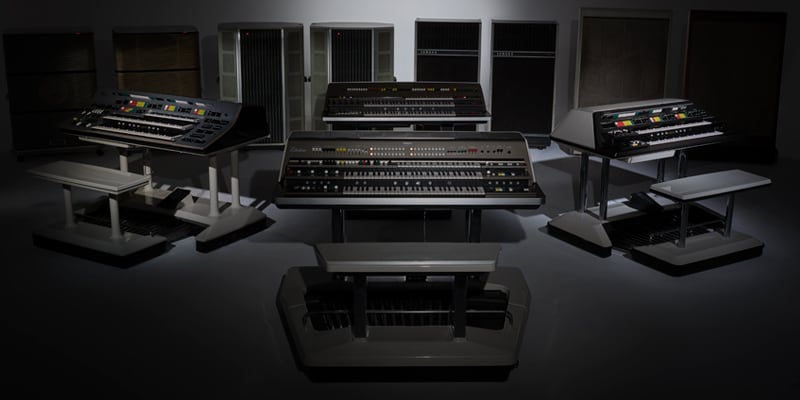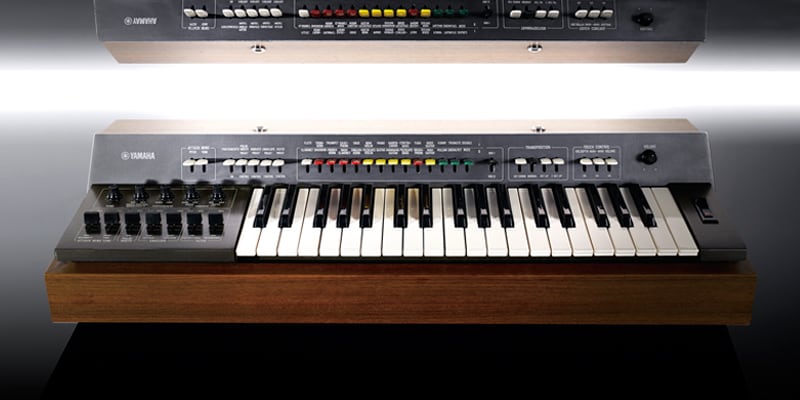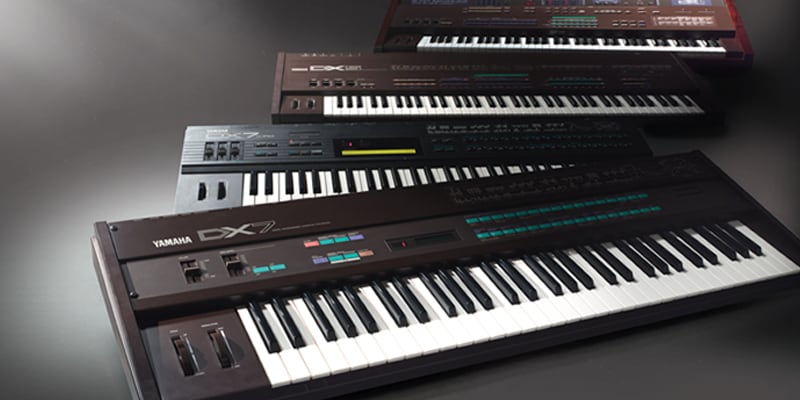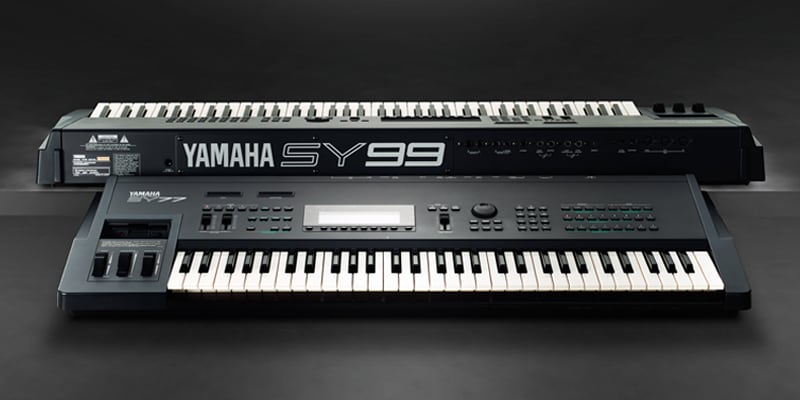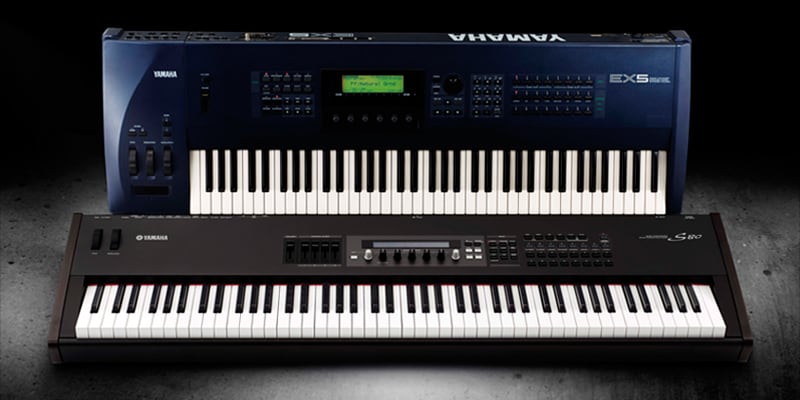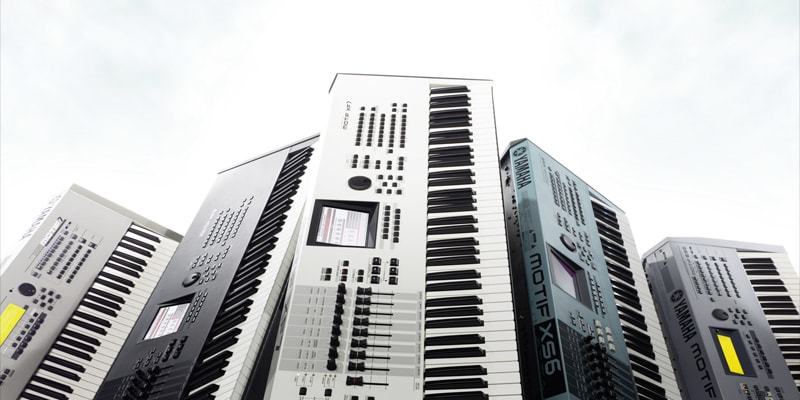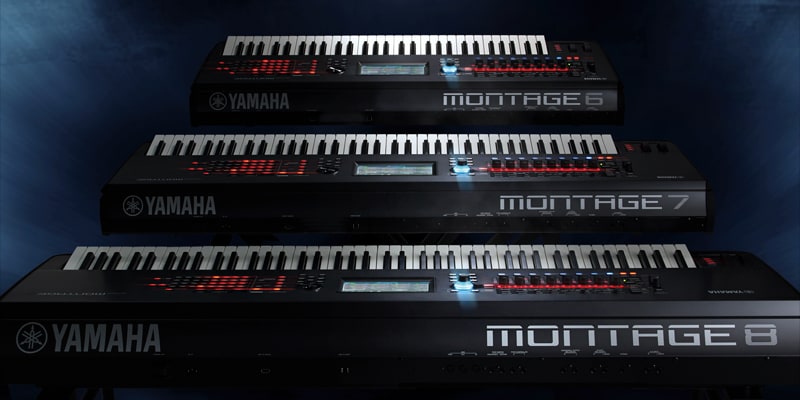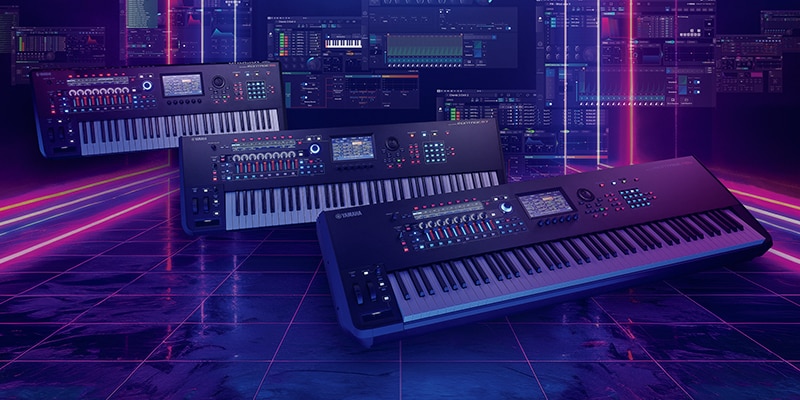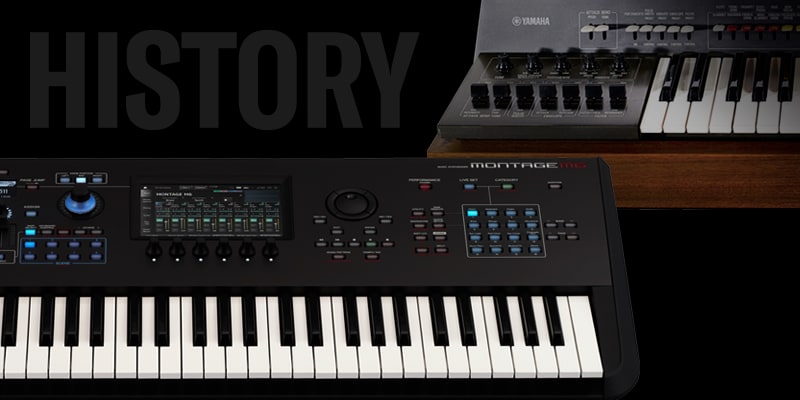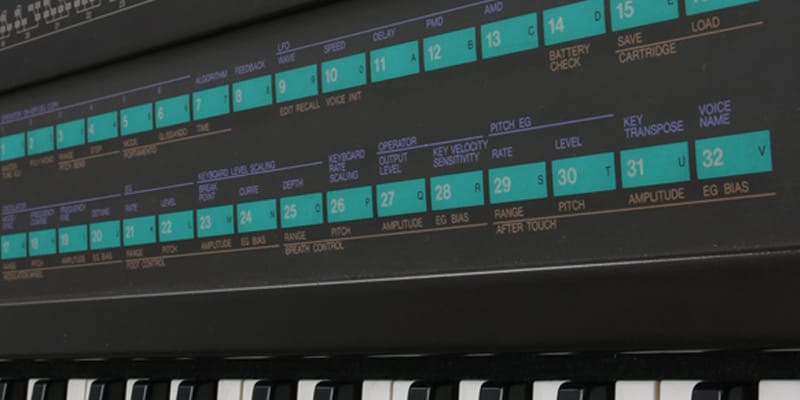Chapter 1: Origins of the Yamaha Synthesizer
Evolution from the Electone

Technologies and products that could be considered prototypes of the first electronic musical instruments have been around since the 1920s, but none has a closer association with popular music than the electronic organ. The Electone® ("Electone" is the product name [and trademark] used for our electronic organs) debuted in 1959 with the D-1. Similar musical instruments based on vacuum-tube technology were already available at the time, but the D-1 was revolutionary in that its modules relied on transistors alone. Although the Electone set the stage for the modern synth in terms of sound generation, it lacked the expressivity of acoustic instruments to such a degree that the president of Yamaha at the time referred to it as a mere "musical toy." The instant one played a key, the instrument produced a tone that ceased immediately with an abrupt mechanical cutoff sound when the key was released.
Various research projects identified the most important factor in interpreting the authentic sound of a musical instrument: the way in which a tone changes over time. Consider the piano as an example: the tone produced when a key is played includes complex harmonics generated by the physical striking of the string. As the sound sustains, however, it gradually comes to resemble a wave with less harmonic content—such as a sine wave. This specific sonic variation over time is the most distinctive characteristic that allows us to identify the sound of the piano. Yamaha realized that the development of technologies capable of recreating these changes in sound were critical in producing the natural-sounding voices of acoustic instruments. In reality, our history of synthesizer development actually began with this variation of sound over time – and our quest to make the Electone produce more interesting sounds.
Why Digital Technology in an Analog Synth?
The tone producing system used in the first-generation Electone was extremely simple. Each key on the keyboard had its own oscillator—or what we now call a “tone generator”—which would generate a sound whenever its key was played. If the keyboard had 40 keys, the instrument would have 40 oscillators, with each pair operating in much the same way as a switch and buzzer. In reality, an octave divider—a device that can divide frequencies by any integer value—was used to produce tones in lower octaves; therefore, the instrument just needed enough oscillators to produce the 12 highest notes in its range—namely, top octave division method. Nevertheless, the decision to use new circuits capable of modifying sound over time as described above would have meant providing one for each and every key on the keyboard. Given the state of technology at the time, this would have made the design extremely expensive and resulted in an instrument that was unfeasibly large.


It became clear that new control technology was required. If, for example, an instrument had eight control circuits, it could generate up to eight polyphonic tones—that is, eight different notes at the same time. But if it also had 36 keys in a three-octave configuration, new technology was needed to determine which of the circuits to trigger in response to the playing of a particular key. Our solution was to introduce a device that could assign circuits to keys based on the order in which they were played, the total number of keys currently being held down, and other related factors.
This type of device was known as a key assigner, the predecessor of today's dynamic voice allocation (DVA) technology. Back in the early seventies, when tone generators still relied on analog technology, digital circuitry was already being used in these key assigners. Their adoption was an important milestone in the introduction of digital technology in the analog-synth era.
Birth of the SY-1

In 1973, Yamaha completed work on a prototype codenamed the GX-707. Based on cluster voltage control, this instrument could be regarded as the predecessor of the Electone GX-1. Although it looked just like an Electone, the GX-707 was actually an eight-note polyphonic synthesizer—more specifically, the upper and lower keyboards supported eight-note polyphony, while the solo and pedal keyboards were both monophonic. As the flagship model in the Electone lineup, however, this prototype was conceived of as a "theatre model" for use on the concert stage. With a console weighing more than 600 pounds, and a separate board required for editing tones, it wasn’t ideal for the general public. To this day, it’s considered a niche instrument. Yet the GX-707 did possess extremely expressive tone generators: technology Yamaha elected to use in a separate solo-part keyboard product for use with existing Electones. And so, the GX-707 prototype became the SY-1 monophonic synthesizer: the first synth from Yamaha upon its release in 1974. Given that analog synthesizers have typically evolved from monophonic to polyphonic, this reverse pattern—namely, moving from poly to mono—is further evidence of our history of thinking in unique ways.

Although the SY-1 lacked a key assigner, it did feature an envelope generator for altering its sounds over time. The envelope generators used in synthesizers typically comprise four stages, identified by the letters ADSR. "A" stands for attack time—the adjustable time between pressing of a key and the resulting note reaching its peak level. The decay time—represented by "D"—defines how long it will take for the sound to drop from this peak to the sustain level when the key is held down. This sustain level—indicated by "S”—is the constant volume that notes ultimately reach. And the release time—represented by the "R"—specified the length of time for the sound to fade away completely once the key has been released.
Normally, one would use a controller for each of these parameters to adjust how the sound should change over time in response to playing, holding, and releasing the keys. However, the SY-1 control panel lacks the knobs provided on modular synths such as the Moog and Minimoog for configuring the ADSR stages of amplitude and filter envelopes. Instead, a pair of sliders labeled Attack and Sustain were used to adjust the amplitude envelope, and a feature called Attack Bend allowed the pitch and filter envelopes at the beginning of the note to be adjusted in a unique way.
The SY-1 featured a range of preset envelopes for recreating the sound of various instruments such as the flute, guitar, and piano which could be activated simply by moving the tone levers. Today, these presets are standard, but the inclusion of this functionality in the very first Yamaha analog synthesizer was highly innovative.
Another groundbreaking feature of the SY-1 was touch control, or what’s known today as velocity sensitivity. Prior to the introduction of the SY-1, electronic organs had typically been equipped with a volume or expression pedal could be used to modulate sound while playing. However, Yamaha had been working on a range of prototypes with the aim of modulating tone based on how hard or softly the keys were played. Ultimately, we perfected a technology that measured the strength of volume by how long it took for keys to be fully pressed down. It was this system that debuted in the SY-1.
Crossover to CS Series Combo Synthesizers

In 1975, one year after releasing the SY-1, Yamaha introduced the GX-1 as a concert-model Electone. However, the first non-Electone products to inherit the unique technologies of the SY-1 were the combo synthesizers of the CS Series.
One of the most notable features of the CS synths was the integrated circuitry used in their tone generators and controllers—components that had up until then taken the form of transistor assemblies. This integration of state-of-the-art technology paved the way for huge weight reductions, vastly improving portability. Consider, for example, the GX-1 and the top-of-the-line CS synth, the CS-80. While these two instruments certainly differed in terms of design and mode of use, the GX-1 weighed in at over 600 pounds and had a price tag of approximately $49,000. By contrast, the CS-80 was only 180 pounds and cost approximately $9,000, making it far more accessible in cost and weight for the average musician.


At the time, Yamaha synthesizers had two very distinct features, the first of which was the ability to retain programmed sounds. These days, we think nothing of storing our original sounds in an instrument's memory much the same way as saving a file on a computer. Back in the seventies, however, neither RAM nor ROM existed, so an analog approach was employed to store sounds. The following illustration shows part of a page from the CS-60 service manual which was used by technicians when repairing the instrument. This section, titled (Tone Preset 1) Circuit, contains instrument names, resistance values, and a circuit diagram. The synthesizer's levers were connected to variable resistors—that is, circuit elements that can limit current and voltage. As shown, however, fixed resistance values corresponding to specific positions of these levers are built into this circuit. The combination of these values resulted in a certain sound or tone, leading these circuits—which were widely used back then—to be called "tone boards."
In instruments like the GX-1, tone boards were physically inserted and removed to change sounds. As such, Yamaha employed a sound storage method not unlike analog-type ROM cartridges. The CS-80, meanwhile, possessed functionality that allowed instantaneous switching between four original sounds. Specifically, it had four complete sets of memory elements, with one memory element from each set corresponding to a specific instrument controller. Each of the four sets could be used to store all the controller positions for a user-created sound.


The other distinctive feature of Yamaha synthesizers was IL-AL type envelope generators. IL and AL refer to Initial Level and Attack Level, respectively. These envelope generators used a slightly different approach to that of the standard ADSR type. In an ADSR envelope, the value corresponding to the very start of the attack stage is the base value: zero. When we apply the envelope produced by such a generator to a filter, the tone at the start of the sound is determined by the current cutoff-frequency setting. However, the tones at the peak of the attack and during the sustain are shaped by the cutoff frequency setting, in combination with the envelope generator depth and sustain level. Because these tones are the result of multiple settings, adjusting the way in which a sound changed over time could become quite confusing. In contrast, when applying an envelope with Initial Level and Attack Level settings, the filter's cutoff frequency determines the tone produced while the note is held. The IL and AL controllers independently set the tones at the start and peak of the attack stage. This approach provided a much higher degree of freedom, especially when trying to recreate natural-sounding tones. As a unique Yamaha feature, the IL-AL type envelope generator further demonstrated the commitment of our developers to high-quality sound creation.

The CS-80 was also equipped two landmark features: a portamento bar, known as the ribbon controller, which could be used to bend the pitch smoothly, as well as aftertouch functionality that could detect the pressure applied to each sustained key and change the tone accordingly. Given that these functions remain extremely popular in modern synths, the fact that Yamaha devised and implemented them four decades ago underscores the technical excellence of our synthesizer development team.
Lower Prices, More Compact Designs, and Further Enhancement

In the latter half of the seventies, we expanded the CS Series with low-priced monophonic synthesizers. Because of their affordability, their popularity grew. Additionally, due to rapid advancements in electronic circuit integration and their low cost, the CS-5, introduced in 1978, weighed only 15 pounds and cost just $432.00.
Many of the technologies and features of today's Yamaha synths were first realized during the development of compact, affordable instruments such as these. For example, the wheel-type pitch bend and modulation controllers of the CS-15D have become distinctive features of our instruments that are still utilized today, including in our latest MONTAGE M series. In 1979, we released the CS-20M, which used digital technology to store sounds. The CS-70M, introduced in 1981, was very similar to modern instruments in terms of functionality. In particular, it offered an auto-tune function that solved the perennial tuning problems encountered in analog synthesizers, and also featured a built-in sequencer that used a dedicated microprocessor.
The CS01 of 1982 was a truly pivotal synthesizer. Capable of running on batteries, and equipped with a mini keyboard, a built-in speaker, and shoulder-strap pins among other features, it ushered in new era in terms of both sound synthesis and mode of use.
Inspired to Create New Forms of Synthesis

Since its beginnings in 1974, synthesizer development at Yamaha has unfolded in parallel with many other advancements in tone generation technologies that also began back in the seventies. Notable examples are research into FM synthesis, which became extremely popular in the eighties, and the hybrid Pulse Analog Synthesis System (PASS), which combined digital and analog technologies, and was adopted for use in Electone tone generators in 1977. Recordings of the sounds from these prototype technologies reveal that the analog synthesis approach used in the SY-1 had already been perfected to a commercially viable level. In this regard, it’s remarkable how quickly the Yamaha developers of the time identified so many highly promising new technologies and immediately put them to use.
Still, many issues concerning sound quality needed to be resolved. One particularly challenging problem was how to make these new instruments as expressive as their acoustic counterparts. Changes in tone and volume over time were critical in this regard, prompting continuous, round-the-clock research and development in the pursuit of better sounds to satisfy this need. Perhaps symbolic of the high-growth period of the Japanese economy, the then-president of Yamaha is said to have instructed his team to "spend whatever you want, but give me something that can be the best in the world." With such passion and devotion, synthesizer development at Yamaha during the seventies did more than give birth to a dazzling array of original technologies—it undoubtedly laid the foundations for the coming popularization of the synthesizer as a musical instrument.






